Latam Airlines Bundle
Who Really Owns Latam Airlines?
The ownership of an airline giant like LATAM directly impacts its strategic direction and financial health. Knowing who controls LATAM Airlines is crucial for understanding its future prospects and investment potential. This knowledge is especially vital considering LATAM's recent restructuring and the evolving dynamics of the airline industry. Uncover the key players shaping the future of this major Latin American airline.
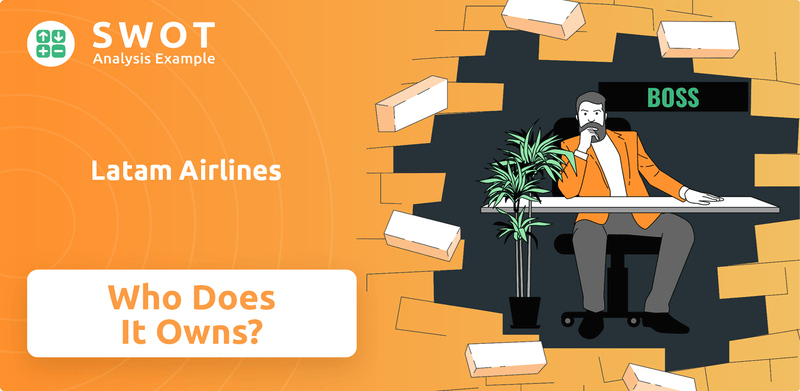
Understanding the Latam Airlines SWOT Analysis is key to making informed decisions about the company. The journey of LATAM Airlines, from its founding to its current structure, reveals a fascinating story of mergers, strategic investments, and financial challenges. This exploration of Latam Airlines ownership will provide a comprehensive understanding of who owns Latam, including its major stakeholders and how they influence the company's operations and strategic decisions. Examining the Latam Airlines owner structure is crucial for anyone interested in the company's financial performance and future trajectory.
Who Founded Latam Airlines?
The formation of LATAM Airlines Group S.A. in 2012 marked a significant shift in the aviation landscape, born from the merger of two major South American airlines: LAN Airlines of Chile and TAM Airlines of Brazil. Understanding the early ownership structure of these foundational entities is key to grasping the initial shareholder base and the subsequent evolution of Latam Airlines ownership.
LAN Airlines, originally established in 1929 by the Chilean government, transitioned to private ownership over time. The Cueto family emerged as a dominant shareholder, wielding considerable influence through various holding companies. TAM Airlines, founded in Brazil in 1961 as Transportes Aéreos Marília, saw the Amaro family, particularly Rolim Amaro, play a crucial role in its growth and development, ultimately becoming the primary controlling shareholders.
The merger agreement between LAN and TAM involved a complex share exchange, with TAM shareholders receiving shares in the newly formed LATAM Airlines Group. This process, while diluting individual stakes, ensured that both the Cueto and Amaro families remained significant shareholders in the combined entity. Their long-standing visions for regional airline dominance were instrumental in the creation of LATAM.
LAN Airlines, later LAN Chile, was initially founded by the Chilean government in 1929. It was a state-owned enterprise that gradually transitioned to private ownership.
The Cueto family became a significant controlling shareholder of LAN Airlines. They held a substantial stake through various holding companies, influencing strategic decisions.
TAM Airlines started in Brazil in 1961 as Transportes Aéreos Marília. The Amaro family, particularly Rolim Amaro, were key figures in its development.
The merger involved a share exchange where TAM shareholders received shares in the new LATAM Airlines Group. This diluted individual stakes but kept major shareholders involved.
The Cueto family, through Costa Verde Aeronáutica S.A., and the Amaro family were the primary private shareholders who drove the creation of LATAM.
Early agreements would have included provisions for board representation and strategic control, reflecting the contributions of the merging airlines.
The initial ownership structure of LATAM Airlines Group was shaped by the merger of LAN and TAM, with the Cueto and Amaro families as key shareholders. While specific equity splits are complex to determine due to the merger's nature, their influence was pivotal. The company's history reflects a strategic vision for regional dominance, with the founders' decisions significantly impacting the airline's trajectory. To learn more about the company, you can read this article about Latam Airlines ownership.
The merger of LAN and TAM created LATAM Airlines Group, with the Cueto and Amaro families as foundational shareholders.
- The Cueto family, through Costa Verde Aeronáutica S.A., and the Amaro family were the primary private shareholders.
- The merger involved a share exchange, with TAM shareholders receiving shares in the new LATAM Airlines Group.
- Early agreements likely included provisions for board representation and strategic control.
- The founders' decisions significantly impacted the airline's trajectory.
Latam Airlines SWOT Analysis
- Complete SWOT Breakdown
- Fully Customizable
- Editable in Excel & Word
- Professional Formatting
- Investor-Ready Format
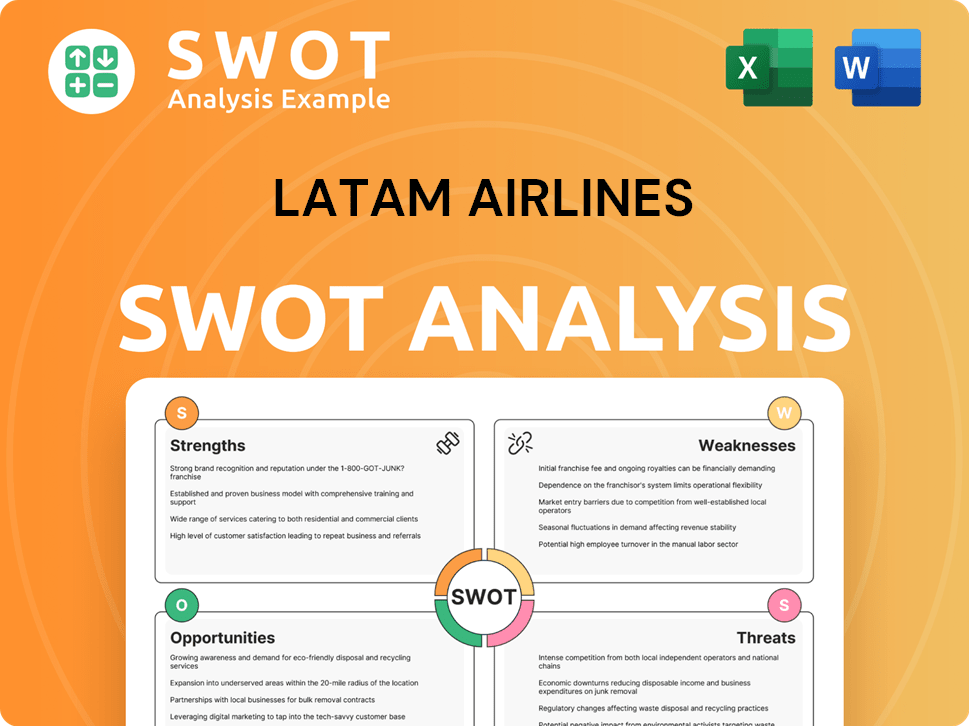
How Has Latam Airlines’s Ownership Changed Over Time?
The ownership structure of LATAM Airlines has seen significant shifts since its formation in 2012. A pivotal moment was the Chapter 11 bankruptcy proceedings initiated in May 2020 and its emergence in November 2022. Before the bankruptcy, major shareholders included the Cueto family, Qatar Airways, and Delta Air Lines. Delta Air Lines acquired a 20% stake in 2019, aiming to expand its presence in Latin America. Qatar Airways also held a significant portion of the company's shares.
The Chapter 11 reorganization significantly reshaped the ownership landscape. The approved plan involved a substantial capital increase and debt conversion into equity. Pre-bankruptcy shareholders experienced dilution. Post-restructuring, key stakeholders include new equity holders from the bankruptcy process, creditors, and existing shareholders who participated in the capital increase. Delta Air Lines, Qatar Airways, and the Cueto family remained important, but their percentage ownership changed. As of April 2024, Delta Air Lines holds approximately 10% of LATAM's shares. The Cueto family, through Costa Verde Aeronáutica S.A., also maintains a notable stake. These changes have influenced company strategy, emphasizing financial deleveraging and operational efficiency.
| Shareholder | Pre-Bankruptcy Ownership | Post-Restructuring Ownership (Approximate, April 2024) |
|---|---|---|
| Delta Air Lines | 20% | 10% |
| Cueto Family | Significant | Notable |
| Qatar Airways | Around 10% | Adjusted |
The evolution of Latam Airlines' ownership reflects its journey through financial challenges and strategic realignments. The current ownership structure, with Delta Air Lines and the Cueto family as key stakeholders, indicates a focus on stability and growth post-restructuring. Institutional investors and investment funds also play a role in the company's ownership, influencing its strategic direction.
The ownership of Latam Airlines has changed significantly, particularly after its bankruptcy.
- Delta Air Lines and the Cueto family are major shareholders.
- The Chapter 11 process led to a restructuring of the ownership.
- The company's strategy now emphasizes financial stability and operational efficiency.
- Institutional investors also hold significant shares.
Latam Airlines PESTLE Analysis
- Covers All 6 PESTLE Categories
- No Research Needed – Save Hours of Work
- Built by Experts, Trusted by Consultants
- Instant Download, Ready to Use
- 100% Editable, Fully Customizable
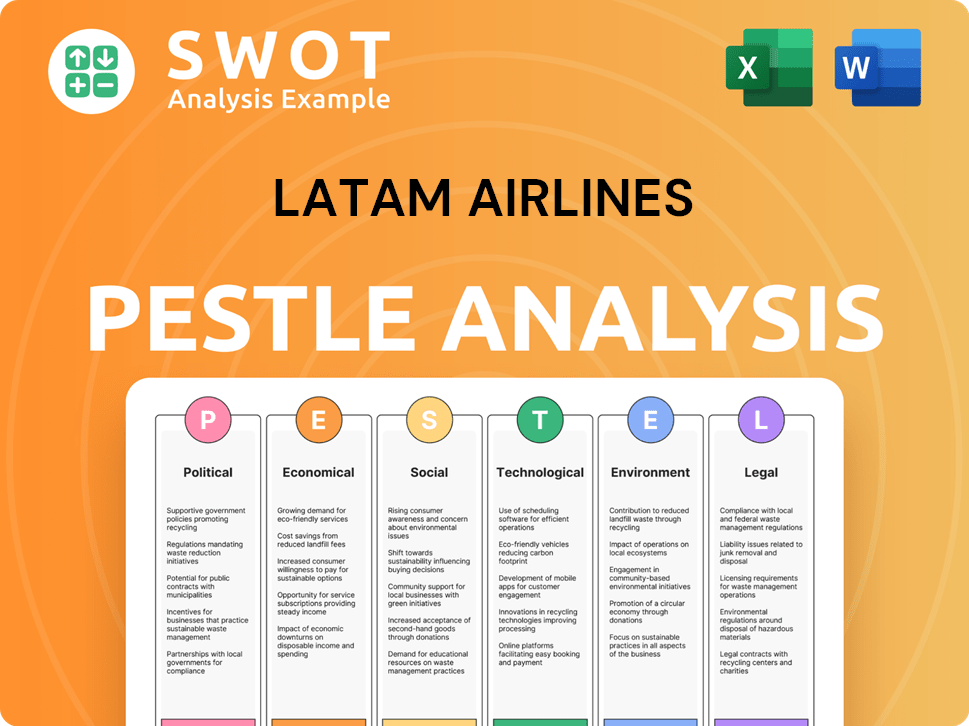
Who Sits on Latam Airlines’s Board?
The Board of Directors of LATAM Airlines Group is key in representing shareholder interests and guiding the company's strategic direction. As of early 2024, the board includes members from major shareholders and independent directors. Key shareholders like the Cueto family and Delta Air Lines typically have representation, reflecting their ownership stakes and influence. For example, Ignacio Cueto Plaza serves as the Chairman of the Board, showing the continued influence of the Cueto family. The composition can change, but these core stakeholders maintain a strong presence.
The board's focus has been on strengthening the company's financial position, improving its route network, and increasing operational efficiency. This is all happening under the supervision of a reconfigured ownership base following the restructuring. This restructuring was a complex negotiation among various creditor and shareholder groups, which ultimately shaped the current governance structure. The influence of large shareholders is primarily exercised through their significant ownership percentages and their ability to appoint directors.
| Board Member | Title | Affiliation |
|---|---|---|
| Ignacio Cueto Plaza | Chairman of the Board | Cueto Family |
| Roberto Alvo | CEO | LATAM Airlines |
| Anko van der Werff | Director | Delta Air Lines |
The voting structure of LATAM Airlines Group usually follows a one-share-one-vote principle for its ordinary shares. The presence of strategic investors like Delta Air Lines on the board helps with partnerships and broader strategic goals. Understanding Latam Airlines’s growth strategy also gives insight into the board's objectives.
The Cueto family and Delta Air Lines are major stakeholders in LATAM Airlines.
- The Board of Directors includes representatives from major shareholders.
- Ignacio Cueto Plaza is the Chairman of the Board.
- The company is focused on financial stability and operational efficiency.
- The voting structure is generally one-share-one-vote.
Latam Airlines Business Model Canvas
- Complete 9-Block Business Model Canvas
- Effortlessly Communicate Your Business Strategy
- Investor-Ready BMC Format
- 100% Editable and Customizable
- Clear and Structured Layout
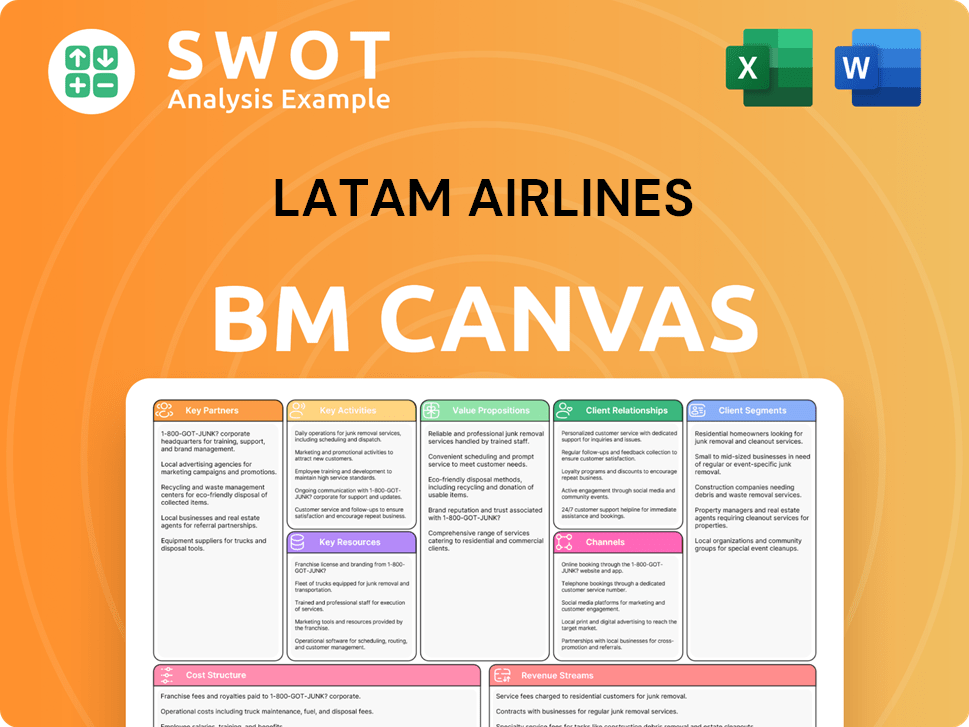
What Recent Changes Have Shaped Latam Airlines’s Ownership Landscape?
Over the past few years, the ownership structure of Latam Airlines has been significantly reshaped by its Chapter 11 bankruptcy proceedings and subsequent emergence. The most impactful event was the financial restructuring completed in November 2022. This restructuring involved a substantial deleveraging of the company's balance sheet and a major recapitalization, which fundamentally changed its shareholder base. The restructuring plan injected approximately $8 billion through a combination of capital increases, convertible bonds, and new debt, which led to considerable dilution for pre-petition shareholders.
Following the restructuring, key ownership trends reveal a more diversified shareholder base with increased participation from institutional investors and creditors who converted debt into equity. While the Cueto family and Delta Air Lines remain important shareholders, their proportional ownership has been adjusted. For instance, Delta Air Lines' stake in Latam was around 10% as of April 2024, a decrease from its pre-bankruptcy 20%. Qatar Airways, another pre-bankruptcy shareholder, also saw its stake adjusted through the process. There have been no major share buybacks or secondary offerings reported immediately after the restructuring, as the company has focused on stabilizing its financial position. The airline industry, generally, has seen a trend towards consolidation and strategic partnerships, and Latam's relationship with Delta Air Lines exemplifies this, even as their equity stakes have evolved.
| Shareholder | Approximate Stake (April 2024) | Notes |
|---|---|---|
| Delta Air Lines | ~10% | Reduced from pre-bankruptcy level |
| Cueto Family | Significant, but adjusted | Key pre-bankruptcy shareholder |
| Institutional Investors | Increased Participation | Converted debt to equity during restructuring |
| Qatar Airways | Adjusted | Pre-bankruptcy shareholder |
Looking ahead, the company's public statements and analyst reports indicate a continued focus on strengthening its financial health and leveraging its strategic alliances. This may result in further subtle shifts in ownership as it optimizes its capital structure and pursues growth opportunities in the dynamic Latin American aviation market. For more insights into the company's strategic moves, consider exploring the Growth Strategy of Latam Airlines.
Latam Airlines' ownership has changed post-bankruptcy.
Delta Air Lines and the Cueto family remain key stakeholders.
Institutional investors now hold a larger share.
Qatar Airways' stake has been adjusted.
The restructuring involved significant financial changes.
Shareholder base is now more diverse.
Focus on strengthening financial health.
Strategic alliances are key for future growth.
Delta Air Lines holds a significant stake.
The Cueto family remains a key owner.
Institutional investors have increased their presence.
Ownership has evolved post-restructuring.
The restructuring brought in new investors.
Debt was converted into equity.
The company is focused on financial stability.
Strategic partnerships are important for the future.
Latam Airlines Porter's Five Forces Analysis
- Covers All 5 Competitive Forces in Detail
- Structured for Consultants, Students, and Founders
- 100% Editable in Microsoft Word & Excel
- Instant Digital Download – Use Immediately
- Compatible with Mac & PC – Fully Unlocked
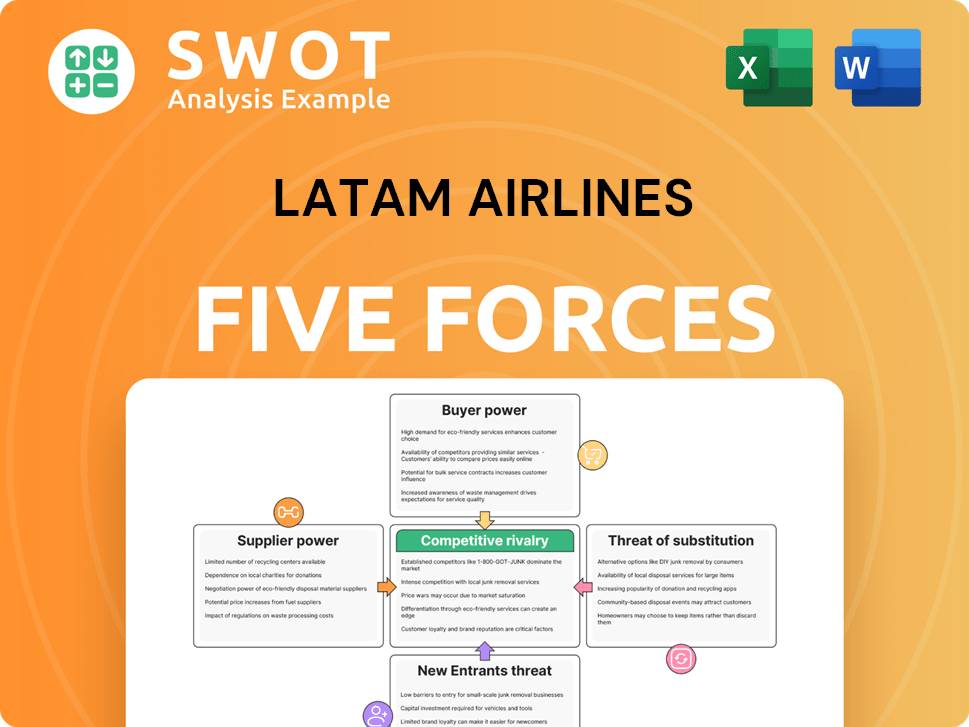
Related Blogs
- What are Mission Vision & Core Values of Latam Airlines Company?
- What is Competitive Landscape of Latam Airlines Company?
- What is Growth Strategy and Future Prospects of Latam Airlines Company?
- How Does Latam Airlines Company Work?
- What is Sales and Marketing Strategy of Latam Airlines Company?
- What is Brief History of Latam Airlines Company?
- What is Customer Demographics and Target Market of Latam Airlines Company?
Disclaimer
All information, articles, and product details provided on this website are for general informational and educational purposes only. We do not claim any ownership over, nor do we intend to infringe upon, any trademarks, copyrights, logos, brand names, or other intellectual property mentioned or depicted on this site. Such intellectual property remains the property of its respective owners, and any references here are made solely for identification or informational purposes, without implying any affiliation, endorsement, or partnership.
We make no representations or warranties, express or implied, regarding the accuracy, completeness, or suitability of any content or products presented. Nothing on this website should be construed as legal, tax, investment, financial, medical, or other professional advice. In addition, no part of this site—including articles or product references—constitutes a solicitation, recommendation, endorsement, advertisement, or offer to buy or sell any securities, franchises, or other financial instruments, particularly in jurisdictions where such activity would be unlawful.
All content is of a general nature and may not address the specific circumstances of any individual or entity. It is not a substitute for professional advice or services. Any actions you take based on the information provided here are strictly at your own risk. You accept full responsibility for any decisions or outcomes arising from your use of this website and agree to release us from any liability in connection with your use of, or reliance upon, the content or products found herein.